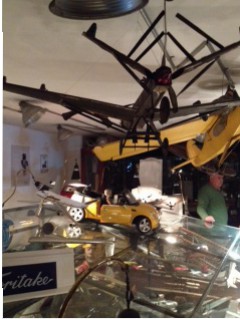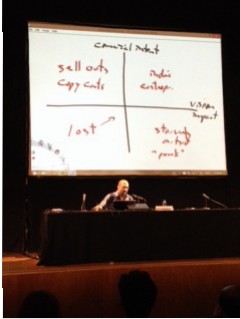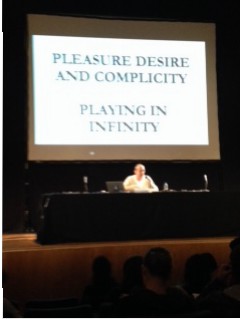 My disease is getting worse. The virus is spreading through my brain… I think I am really starting to care about what a game is. Such things are usually a sign of immaturity because one needs to fight for one’s object as if one’s survival depended on it but it’s also a sign of aging as one begins to question one’s choice of object in the first place. This is a fair characterization of my inner conflict during Transitio_MX 06: the Festival de Artes Electronicas y Video held in Mexico City Sept 25th to October 4th, 2015.
My disease is getting worse. The virus is spreading through my brain… I think I am really starting to care about what a game is. Such things are usually a sign of immaturity because one needs to fight for one’s object as if one’s survival depended on it but it’s also a sign of aging as one begins to question one’s choice of object in the first place. This is a fair characterization of my inner conflict during Transitio_MX 06: the Festival de Artes Electronicas y Video held in Mexico City Sept 25th to October 4th, 2015.
Lynn and Skot have already reported on the myriad adventures of the TAG team that was so graciously invited to speak at the symposium, collaborate on a workshop and curate a portion of the fairly large “game” exhibition at the festival. I was just a speaker and a minor one at that, I was really there to learn. It will go down in the annals as something of an amazing experience. Maybe we were too cliquish but there is something to be said about collectively sharing a research/creation oriented experience like this – we were clearly not in seclusion and the co-implication of the urban culture around us (partly exemplified in Skot’s report) bled through the experience of the exhibition, the stutters of translation and mis-translation, and the crazy mash up of interesting artists, scholars and students (plus an earthquake warning).
But back to the issue at hand — where are the games? Surely the festival and symposium (not to mention the mass hypnosis) was partly about struggling with that question but it seemed to me that the inescapable popularity of video games as mass cultural commodities remains a source of frustration/concern for media artists. That is, if media artists are going to talk about video games, curate video games, and make video games then they absolutely cannot be identified with “those” games. Remember I am trying to be provocative here but why must there be all this deep stretching and straining to somehow recuperate video games as progressive (especially radically progressive) artistic, political, educational, critical and so on. The media arts are already full of all of this so what is the gambit? What is to be gained? Why do the media arts need to deal with games at all?
The question was highlighted for me through several linked experiences at Transito. The first is the symposium keynotes which started with Jason della Rocca doing his thing on industry dynamics and finished with Bernard Stiegler sort of talking about games in the context of James Carse’s Finite and Infinite Games (1987). Could we imagine a more disjunctive couple of bookends? I am still struggling to figure out if these two guys could be seen at all to be talking about the same thing even though both liberally used the word “games” in their talks.
The best I can do is to see Stiegler doing his darnedest to create a post-psychoanalytic theoretical opening for maybe talking about the play of mass culture video games as having some weight of “the infinite” about them. I will not begin to try and unpack Stiegler’s talk here but I’ll report that I was impressed with the layers and implications of Stiegler’s argument for thinking through concepts of pleasure and desire in digital culture in interesting new ways. In any case, Stiegler was comfortable talking about interactivity, emergence and other standard tropes already extant in the media arts but certainly not video games (I think he needs to hang out with Patrick Crogan some more). On the flipside, Jason della Rocca tried hard to find that pocket of the industry world he is implicated in that the media arts people could identify with as he worked his semiotic square magic producing quadrants of indie-artist producers and an account of the aesthetics of 8bit retro and abstraction mechanics in terms of the higher production costs of realism vs interactivity. Some may find this strange but della Rocca was pretty much the only political economist in the room!
Then there was the exhibition itself. I’ll note that this was not meant as a game exhibition so much as media arts meets game-ishness thing. I am starting to get better at going to these things (when they are not late at night) and pondering context and I think game curation is a bit stuck between the contextual trappings of gallery based art (individuation of works, plinths, little placards with names, title and date, obsession with lighting, etc…) and the arcade and new arcade models of social and convivial play with gamey things. I don’t mean for this to be overly critical and I lay no claim to curatorial expertise but I was struck by the tension between playing the games, and playing with the idea of playing the games. I am going to suggest that most of the works I encountered in the exhibition were about playing with the idea of the game (including my experience of the works chosen by our own team and discussed by Lynn in her blog post). I guess this thought struck me the most when I encountered ‘Papers, Please’ sitting on a plinth at standing height along a wall with a few other PC games… the context of the show already conveyed the sense of what the game was about (there is a write up in the program and the game was across the room from Fran Ilich’s incredible project – sorry I can’t do that justice in this post… just look him up). So the gravitas was already there but the set up barely invites you to start the game let alone get into it long enough to experience how and why that game works so well in producing political affect.
 I honestly don’t know what the solution is but it got me thinking about what curation might mean for spaces other than galleries and public spaces turned into arcades (where you also can’t play Papers, Please). Can’t Steam curation be a legit thing for artists? Can we talk about the curation of games for private spaces? For living rooms, bedtime, saturday mornings? Or do I miss the point? And of course this made me think of our Knight Project and games for libraries, the games we might want to display around the lab for visitors, games in the classroom, and other stuff like that. I know there is nothing new in this in terms of how mass and popular culture gets institutionalized as art through practices of curation and display but in this case I am growing more confident that we are losing the object of games in the process. Its not that we should be curating mass market games but that mass market games (and the game studies that arose from those) point to experiences of gameplay as the locus of meaning. I think there is still lots to think about in terms of curating games vs curating gameplay. Curiously perhaps the “games” that worked the best for me were all the oculus rift experiences (which I guess are like isolation tanks inside the isolation tanks of the gallery space — Oculus VR kind of erases spatial context — you could be anywhere almost). Those and Pippin’s Abramovic Method games of course!
I honestly don’t know what the solution is but it got me thinking about what curation might mean for spaces other than galleries and public spaces turned into arcades (where you also can’t play Papers, Please). Can’t Steam curation be a legit thing for artists? Can we talk about the curation of games for private spaces? For living rooms, bedtime, saturday mornings? Or do I miss the point? And of course this made me think of our Knight Project and games for libraries, the games we might want to display around the lab for visitors, games in the classroom, and other stuff like that. I know there is nothing new in this in terms of how mass and popular culture gets institutionalized as art through practices of curation and display but in this case I am growing more confident that we are losing the object of games in the process. Its not that we should be curating mass market games but that mass market games (and the game studies that arose from those) point to experiences of gameplay as the locus of meaning. I think there is still lots to think about in terms of curating games vs curating gameplay. Curiously perhaps the “games” that worked the best for me were all the oculus rift experiences (which I guess are like isolation tanks inside the isolation tanks of the gallery space — Oculus VR kind of erases spatial context — you could be anywhere almost). Those and Pippin’s Abramovic Method games of course!


